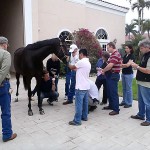
Degenerative joint disease or osteoarthritis is one of the main causes of lameness in horses. DJD occurs when the joint cartilage is destroyed producing pain and inflammation. Typically therapy involves a combination of intra-articular medications such as hyaluronic acid and/or steroids, rest, oral pain medications, shockwave therapy, polysulfated glycosaminoglycans, intravenous hyaluronic acid, and oral supplements that contain glucosamine, avocado soy extracts, MSM and/or chondrotin sulfate.
Joint treatments with IRAP (Interleukin-1 Receptor Antagonist Protein) utilize progressive gene therapy to combat osteoarthritis. Interleukin-1 (IL-1) is a cellular protein that is secreted by many types of inflamed cells. These proteins signal the immune system to attack infected, damaged or dying cells. In the arthritic joint IL-1 plays an important role and accelerates the deterioration of tissues like joint cartilage. IRAP blocks IL-1 from binding to tissues and inhibits the damaging consequences of IL-1.
The process begins with 60 cc of blood from your horse in a special syringe. The syringe is specially prepared with glass beads that stimulate production of the antagonist protein (Il-1a) and an anticoagulant. The process of harvesting, incubating and centrifuging the blood to separate the IRAP abundant plasma from blood takes 24 hours. Thereafter, IRAP joint treatments are administered every 8-10 days for three treatments depending on the condition being treated.
This tip was brought to you by Chuck Maker, DVM (www.alpinehospital.com) and KAM Animal Services, home of KAM’s “Equine Learning Circle” FREE webinars, which take place monthly. These webinars are an expansion of KAM’s weekly tips. Go to www.kamanimalservices.com to sign up for the next webinar. The FREE webinars will conclude with a question and answer session, so be ready with your nutrition questions.


